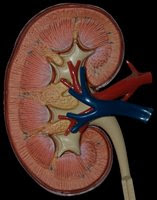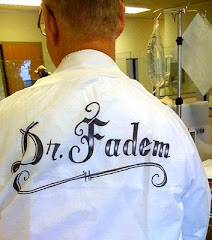Since 1988 the National Kidney Foundation has sponsored a symposium in Houston. It has always featured top experts. This year was no exception. Many new concepts were revealed to the Houston community of nephrologists, nurses, administrators, social workers and dietitians. Myles Wolf started the sessions, and presented key new data from his recently published JCI article
J Clin Invest doi10.1172/JCI46122. This showed that FGF-23, a hormone that rises to keep the serum phosphorus in balance in CKD, was directly toxic to cardiomyocytes, leading to an increase in cardiomyocyte, hence left ventricular hypertrophy. This was independent of klotho, previously thought to be needed for FGF-23 activity. It was demonstrated with an antibody that neutralized FGF-23. Also, in animals treated with that antibody, 1,25 OH D3 levels normalized. This has several implications: 1) it makes it desirable to want to keep FGF-23 levels low in CKD – and since the antibody is not available as a pharmaceutical (yet), we should try to minimize inorganic phosphorus intake. 2) it suggests that vitamin D activation is impaired by FGF-23, not because of reduced renal mass.
Tom Golper’s talk highlighted a paradigm shift in thinking of long term strategies when planning dialysis therapy. He also brought out that in the elderly population with multiple comorbidities, the outcomes were no better with dialysis than without. There are now several studies demonstrating this
NDT (2007) 22(7):1955-1962..
Allen Nissenson outlined the need to integrate health care. The current health delivery system that splits care among a variety of different providers and competing resources is wasteful, and even with the strictest varieties of health reform, will never be cost effective. It is not sustainable. The best system is to have an accountable organization manage the patient’s health care. Concerns that large non-renal groups, be they hospitals or health plans, will not focus on the care that our patients require, and that decision making is best made by those providers and physicians who are highly familiar with kidney patients' special needs.
Amy Friedman started her lecture by asking each of us to look around for a spare kidney, under chairs in bags - and they must be live kidneys. (None found). If we could not find any, she would have to give her talk. She started with the UNOS dialysis trends – there are over 112,000 people waiting for a transplant
(UNOS). In her discussion, she went over terminology changes that were more sensitive to the feelings of donor family members whose loss led to the gains some of our patients enjoyed. (The concept of mourning transcends human experience, as evidenced by the National Geographic quality photographs she took in Puerto Rico of a gila monster grieving over the death of another). She focused on the need for more organ donation, particularly through using extended criteria donors – matching older patients who needed a transplant with kidneys that were recovered from a like population that might be too risky for a younger population. She also focused on the barriers to a successful transplant. Sadly, some of these barriers are regulatory. Doing special viral testing within a few hours of a transplant would only increase ischemia time, and lessen the changes for a successful kidney. Another conundrum revolves around outcomes management. According to outcomes criteria the late Steve Jobs, the well loved founder and CEO of Apple, would have been a poor choice for the liver transplant he received June 23, 2009 because he did not survive for three years afterwards. However, in the two years he did survive he introduced to the world amazing products, including the iPad many of us are using at this moment. There is, however, no app to tell us exactly who will and will not do well with a liver or kidney, and human input and sound clinical judgment are still invaluable.
The day ended with Dr. Emil Abdulhayoglu talking about the various types of AV access. In addition to the standard definitions, however, he explained in a simple and understandable way, the physics that leads to varying outcomes between the different types of access. He very skillfully explained the clinical assessment of a fistula, emphasizing the need to feel the thrill along the fistula tract. The consequences of venous scar build up are venous stenosis or obstruction. Scar formation can appear very early after surgery. One drawback is that the resultant stenosis interferes with the normal maturation of the fistula wall, and the venous wall never develops the muscular change that enables it to seal off after a needle stick. All too often we encounter an infiltration when attempting to cannulate a young fistula that has not properly matured. This failure to mature is likely the result of obstruction that is easily repaired through early intervention prior to the initial cannuation attempt.
A few hiccups with audiovisual equipment not working properly were mostly a nuisance, but did not interfere with the speakers' messages. Unfortunately, Tom Parker was unable to make the symposium as planned, and the audience missed hearing one of the finest doctors in our profession speak to how we can improve the care of our patients. But, Dr. Parker promises to reschedule his trip to Houston, and will be welcome at CKD2012.
Stay tuned for information about the next symposium.
Steve






